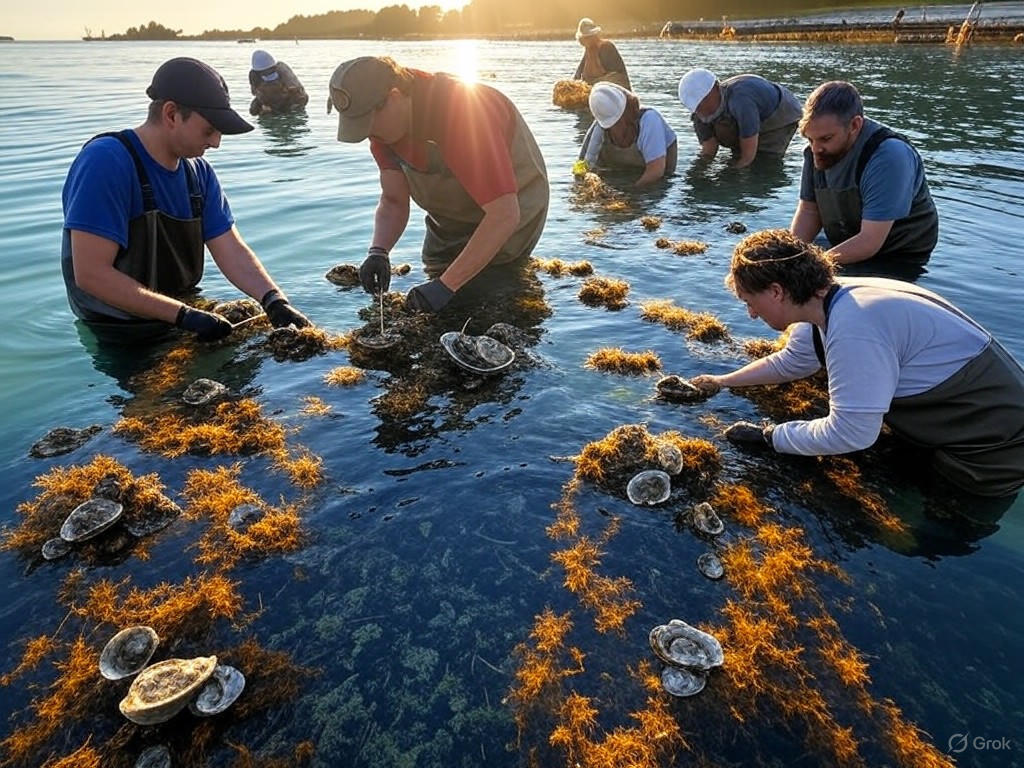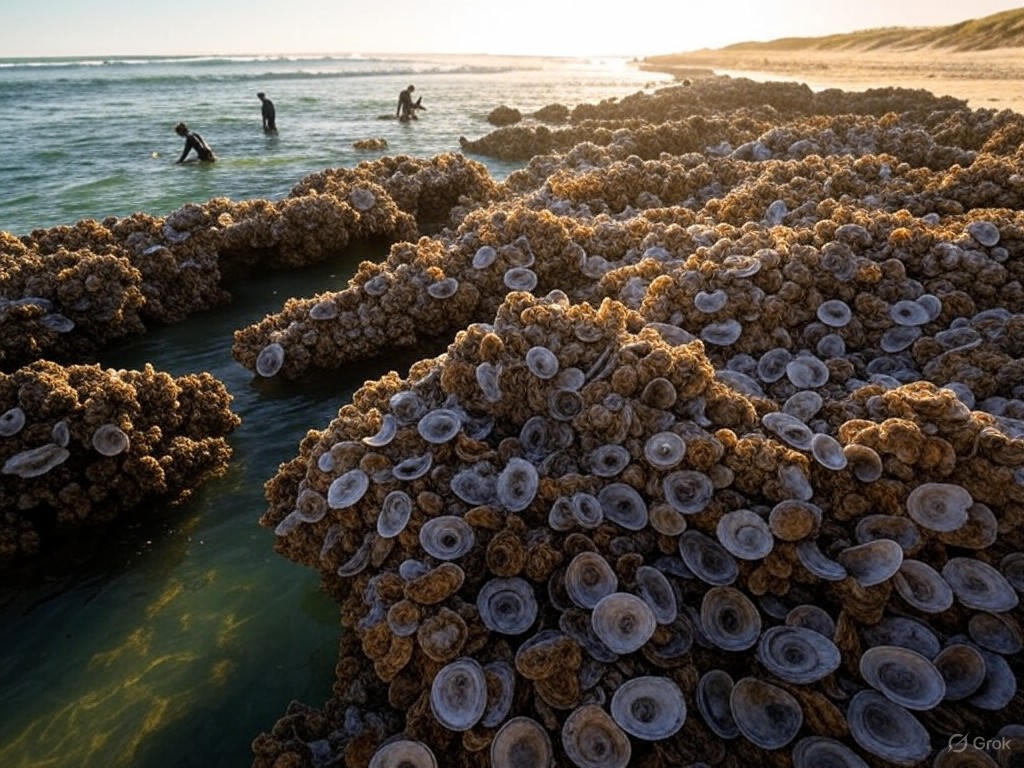Oyster Reef Restoration: Coastal Protection
In the quiet rhythms of coastal tides, where land meets sea, lies a humble yet vital guardian of our marine environment: the oyster reef. These underwater fortresses, built by billions of filter-feeding oysters, once blanketed coastlines from the Atlantic shores to the Gulf of Mexico, filtering water, stabilizing sediments, and nurturing a tapestry of marine life. Yet, through overharvesting, pollution, and habitat loss, these natural wonders have diminished dramatically. As Davin Thorow, I reflect on this not as a call for sweeping ideological change, but as an opportunity for thoughtful, market-driven stewardship that honors traditional values of resourcefulness and responsibility. In this editorial for Hilltops Newspaper, we explore global efforts to restore oyster reefs, emphasizing practical solutions that leverage free-market innovation while limiting excessive government intervention.
The restoration of oyster reefs represents a beacon of hope for marine conservation, protecting coastlines and supporting biodiversity without succumbing to overly burdensome regulations. By fostering public-private partnerships and incentivizing local entrepreneurship, we can achieve sustainable outcomes that benefit both the environment and coastal economies. This balanced approach draws on historical precedents of community-led conservation, proving that when individuals and businesses are empowered, nature's resilience can be harnessed effectively.
The Decline and Vital Role of Oyster Reefs
Oyster reefs have long served as the unsung heroes of coastal ecosystems, acting as natural barriers against erosion and providing habitats for fish, crabs, and other species. Historically, a single oyster reef could filter up to 50 gallons of water per day per oyster, improving water quality and supporting fisheries that sustain traditional livelihoods The Nature Conservancy. Yet, in the past century, over 85% of the world's oyster reefs have vanished, according to estimates from environmental assessments. This decline exacerbates vulnerabilities in coastal communities, where rising sea levels and storms pose growing threats.
In the United States, the Chesapeake Bay stands as a stark example. Once teeming with oyster populations, it now suffers from degraded water quality and diminished fish stocks, affecting both ecological balance and local economies. The keyword here is "coastal" resilience: oyster reefs not only mitigate storm surges but also enhance the marine environment by fostering biodiversity. Without intervention, the loss of these reefs could lead to billions in economic damages from increased flooding and lost fisheries, as detailed in a comprehensive report by the National Oceanic and Atmospheric Administration NOAA Oyster Restoration.
This situation calls for a deliberate, pragmatic response. Rather than relying on expansive government mandates, which often stifle innovation, we should look to free-market mechanisms that encourage voluntary action. Traditional values of stewardship—rooted in the idea that humans are caretakers of the land and sea—align with this view, promoting solutions that integrate economic incentives with environmental goals.

Restoration teams, including local watermen and conservation volunteers, meticulously plant oyster spat in the Chesapeake Bay, demonstrating how community-driven efforts can revitalize marine habitats and protect vulnerable coastlines.
Analyzing Global Restoration Efforts
Globally, efforts to restore oyster reefs have gained momentum, blending scientific innovation with market-based strategies. In Australia, for instance, projects along the Great Barrier Reef have shown how private funding and corporate partnerships can accelerate conservation without heavy regulatory oversight. These initiatives often involve "oyster gardening" programs, where businesses and individuals are incentivized through tax credits or certification programs to cultivate oysters, thereby enhancing the marine environment while creating new revenue streams Wall Street Journal on Marine Economics.
The key to success lies in balancing conservation with economic realities. Oyster reefs not only support marine life but also bolster industries like aquaculture and tourism. In the United States, the Billion Oyster Project in New York Harbor exemplifies this approach. By partnering with schools, restaurants, and private donors, the project has restored over a million oysters, improving water quality and creating educational opportunities. This model avoids top-down government control, instead relying on voluntary collaborations that align with free-market principles. As evidence mounts, studies indicate that such projects yield a high return on investment, with each dollar spent generating multiple benefits in ecosystem services and job creation Environmental Defense Fund Report.
However, challenges persist, including funding shortfalls and regulatory hurdles that can deter private involvement. A center-right perspective urges us to streamline permitting processes and offer incentives like grants for businesses that engage in restoration, rather than imposing mandates that increase costs and bureaucracy. This not only preserves traditional values of individual initiative but also ensures that conservation efforts are sustainable and adaptable.
Evidence of Impact: Success Stories and Data
The evidence for oyster reef restoration is compelling, drawn from both scientific research and real-world applications. In the Gulf of Mexico, collaborative efforts have restored thousands of acres of reefs, leading to a 20-30% increase in local fish populations and reduced coastal erosion Smithsonian Environmental Research Center. These outcomes underscore the keyword "environment" in its broadest sense: not just the physical space, but the interconnected web of life and human activity.
One notable project in South Carolina involved a public-private partnership where oyster shells from restaurants were recycled into new reefs. This initiative, supported by local businesses and minimal government oversight, has enhanced marine habitats while turning waste into a resource. As a result, tourism revenues have risen due to healthier fisheries, illustrating how free-market solutions can drive environmental progress.
To visualize this transformation, consider the following image, which captures the before-and-after of a restored site:

This composite image shows a degraded oyster reef (left) transformed into a thriving habitat (right) through community-led restoration, highlighting the potential for natural recovery when practical incentives are applied.
Such successes are not anomalies. Data from global monitoring programs indicate that restored reefs can recover up to 80% of their original ecological functions within a decade, provided they are supported by adaptive, market-oriented strategies Marine Conservation Society. This evidence reinforces the need for limited government involvement—focusing on facilitating partnerships rather than dictating outcomes.
A Path Forward: Practical Solutions and Conclusion
In concluding, the restoration of oyster reefs offers a model for marine conservation that aligns with center-right principles: empowering individuals and markets to address environmental challenges without overreach. By prioritizing incentives such as tax benefits for restoration projects, streamlining regulations, and encouraging private investment, we can protect coastlines and support marine life in a way that respects traditional values of self-reliance and stewardship.
Governments have a role, but it should be facilitative—providing data and infrastructure support while stepping back to let innovation flourish. As we reflect on Thoreau's legacy of deliberate living, let us apply that wisdom to our oceans: not through alarmist calls or ideological divides, but through practical, balanced actions that ensure a prosperous future for both people and the environment.
Ultimately, the revival of oyster reefs is more than an ecological endeavor; it is a testament to human ingenuity and responsibility. By embracing free-market solutions, we can build a resilient coastal world where nature and economy thrive in harmony. Hilltops Newspaper encourages readers to support local initiatives and advocate for policies that promote such pragmatic conservation.

